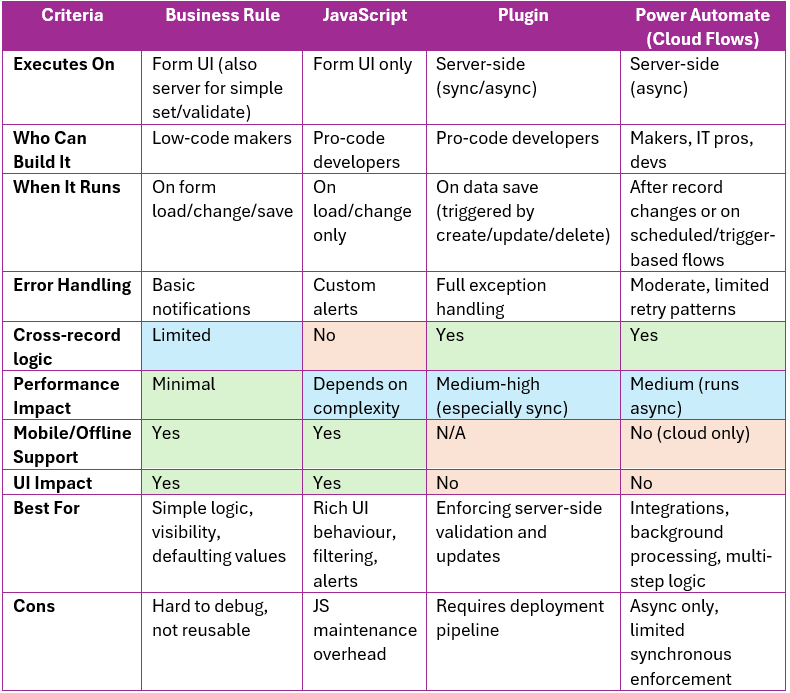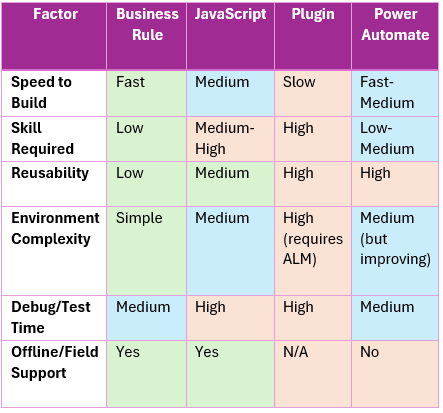When building model-driven apps with Dataverse, you often face a fork in the road: should you implement logic using Business Rules, JavaScript, Plugins, or Power Automate?
Each has its place. Each has its limits.
Choosing the right one depends on where the logic needs to run, who will maintain it, and how reusable, scalable, and enforceable it needs to be — all while aligning to Microsoft’s low-code-first architecture principles.
Here’s how to decide.
🧭 Decision Matrix: At a Glance

🛠️ When to Use What (With Real Examples)
✅ Use Business Rules When:
- You need to toggle visibility, default values, or perform simple field validation.
- The logic is form-centric, not cross-entity or reusable.
- You want a low-code solution editable by admins.
🔹 Example: Make “End Date” required if “Status” = Inactive.
✅ Use JavaScript When:
- You need dynamic field filtering, formatting, or UI customization.
- Custom validation messages or visual alerts are required.
- The logic must run before saving, for immediate feedback.
🔹 Example: Dynamically filter a “Region” lookup based on selected “Country”.
Tip: Keep JavaScript UI-only — avoid embedding critical business logic here.
✅ Use Plugins When:
- You need server-side validation regardless of how data enters the system (form, import, API).
- Your logic spans multiple records or tables.
- You require reusable, enforceable business logic with performance awareness.
🔹 Example: Prevent closing an Opportunity if any related Quote is still active.
Note: Use synchronous plugins carefully — they can delay form save times if overloaded.
✅ Use Power Automate (Cloud Flows) When:
- Logic can happen after a save, and doesn’t need to block the record.
- You need to integrate across multiple services or perform scheduled tasks.
- You want accessible automation with broad reach, including approvals, Teams alerts, email flows, and cross-record updates.
🔹 Example: When a new Contact is created with a referral code, send a welcome email and assign the contact to a specific team.
📐 Microsoft Best Practice: Low-Code First, High-Supportability Always
Microsoft encourages a low-code-first architecture. That means:
- ✅ Start with Business Rules for in-form logic that doesn’t require code.
- ✅ Use JavaScript only for richer UI experiences that Business Rules can’t handle.
- ✅ Centralize logic in Plugins or Power Automate when it must be reused, validated, or executed across tables or apps.
This approach supports:
- Simpler ALM (Application Lifecycle Management)
- Greater maintainability
- Scalable architecture across teams and environments
💡 Example: If you build a Business Rule that needs to be repeated across forms or apps, that’s a sign it probably belongs in a Plugin or Cloud Flow instead.
🧑💻 Developer & Delivery Considerations

📊 Final Thought: Scale by Intent, Not by Habit
When deciding where logic belongs, ask:
- Does this logic need to be reused across forms or apps?
- Can it fail quietly, or does it need enforcement and validation?
- Does it impact user experience, or system data integrity?
- Is it something a maker can safely own and extend?
Choosing the right tool is less about technical capability and more about architecture, ownership, and long-term supportability.
Start with low-code. Scale with intent.


Leave a Reply